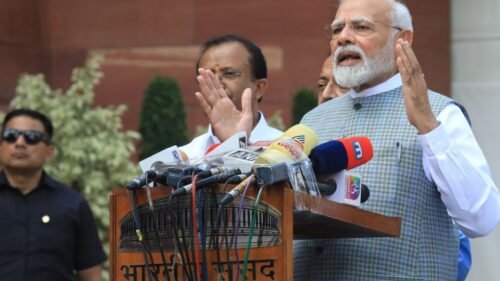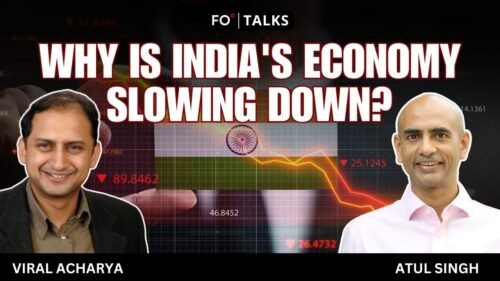The economy of any country is calculated by measuring its GDP, which is broken down into agriculture, industry and service sectors. All over the world, especially in developed countries, there has been a natural progression of growing the economy by agriculture, then progressing onto industry and finally onto services. India also followed a similar trend until 1990, after which services became the backbone of the Indian economy, simultaneously leading to a sharp decline in the agricultural and industrial sectors.
When analyzing the data to determine the GDP, it is necessary to remember that the data provided by the government is unreliable due to the lack of third-party verification. Given its history, data is often fudged and manipulated to suit the government’s purposes. The collection of data is based on outdated ideas, and the method of collection is also questionable. It is not forward-looking in its projections of trends.
A relevant example in today’s economic discussions is the collection of taxes, which serves as a key indicator of an economy’s health and strength. Taxes are essential for funding public services and infrastructure, and they reflect the contributions that businesses and individuals make to their government’s revenue.
However, it’s essential to consider the broader picture: if taxes were reduced, how would that affect economic growth? Understanding the relationship between tax rates and economic performance can provide valuable insights into whether such reductions might stimulate or hinder overall economic growth. Such an approach is proactive and forward-looking compared to the parochial approach of looking backwards.
In terms of India’s GDP figures, they present an illusion of steady growth, but they also conceal the decline of agriculture and industry alongside the distortions created by poor governance. The service sector has expanded, yet it remains reliant on fragile external factors rather than robust domestic foundations.
Without institutional reform and credible policymaking, India’s economy will remain unbalanced, unequal and vulnerable to shocks. As it exists now, the Government of India serves as a lesson to the rest of the world on how not to run a country.
Agriculture: the struggling backbone
The agricultural sector is the largest provider of employment, but its growth rate is the lowest and the smallest component in the Indian economy. The combination of low productivity rates and small farm sizes renders this sector unviable, making it also prone to heavy subsidization in input supply to farmers.
The use of high-yielding seed varieties often necessitates the application of pesticides and fertilizers. However, suppose crop failures occur due to poor monsoon conditions. In that case, this can lead to devastating consequences for farmers, including the tragic phenomenon of farmers’ suicides, as they struggle to meet their financial obligations.
Additionally, the distribution of agricultural commodities through regulated markets tends to concentrate power within the distribution channels, rather than empowering the farmers themselves. Compounding these challenges are inadequate storage facilities in government godowns, which result in significant spoilage and wastage of valuable produce.
Industry: Decline, uncompetitiveness and regulation
The industrial sector, on the other hand, is the largest contributor to the government’s revenue. However, its contribution to India’s GDP has fallen from 17.9% in 1995 to just over 12.5% in 2024. Some sectors, such as calcium carbide, have closed down entirely due to cheaper imports, and many industries, such as soda ash, have been outsourced overseas. This is due to very low import duties, as foreign companies tend to export rather than “Make in India,” which has led large Indian companies to expand overseas instead of within India.
For example, the significant overseas expansion of Indian conglomerates, such as the Tata Group and the Aditya Birla Group, in the early 2000s lends credence to the notion that the industrial climate overseas is better than in India. This has led to the outsourcing of manufacturing overseas, resulting in job losses in India and, consequently, a lack of growth in other allied sectors due to the multiplier effect (the proportional change in income that results from a change in spending).
Indian industry has also become uncompetitive due to high costs of inputs such as power, furnace oil, interest and transportation, which government companies supply. Moreover, the excessive taxation, much of which can’t be set off under the Goods and Services Tax (GST), adds to the costs of production.
Even when exports are involved, prices of products are pushed up by extortionate taxes, making them even more uncompetitive in global markets. In the fiscal year 2024–25, India’s trade manufacturing deficit reached a staggering $190 billion, marking a record increase year-over-year. Notably, the deficit with China alone exceeded $100 billion.
Additionally, the industrial sector is heavily regulated through various acts such as the Factory Act (1948), Air (Prevention and Control of Pollution) Act (1981) and the Occupational Safety, Health and Working Conditions Code (2020), which were intended to encourage industry to adopt good practices. Instead, they have led to an overconcentration of power in the hands of government bodies. A more cost-effective approach would be for international bodies to assume the roles currently held by various state and central government organizations.
The export promotion scheme is developed in isolation from exporters, resulting in no impact on exports. The indiscriminate signing of Free Trade Agreements (FTAs) has also led to increased imports into India, as import duties are significantly below those set by the World Trade Organization (WTO). Very few of these manufacturing companies are competitive internationally, despite having a high valuation in the Indian stock market, which reflects the difficulty in manufacturing rather than being internationally competitive.
Services: growth without support
The services sector has experienced sharp growth since the 1990s, thanks to India’s low labor costs and limited government interference. The openness of foreign countries and companies to outsourcing services to India has led to a significant economic boom in the country. This is due to external reasons — such as natural arbitrage, like water flows from a higher level to a lower level — and not government encouragement.
However, other services, such as tourism, are still very insignificant. The lack of tourists is attributed to poor infrastructure and high hotel and facility costs, resulting in significantly less tourism compared to similar countries like Sri Lanka and Thailand.
The data given by the International Monetary Fund (IMF) only reflects the data provided by the government of India, which is suspect. Hence, the full report prepared by the international bodies does not reflect the reality in India. The poverty in India is largely a result of poor governance rather than a lack of resources.
Indians who go overseas tend to do very well, as the environment provides them with opportunities to flourish and develop their talents, creating a win-win situation for both the individual and the host country. In India, the economy is a complete mess, with politicians and bureaucrats working at cross-purposes. Laws and regulations may appear good on paper, but are counterproductive in reality. It is an open secret that red tape has been killing the economy right since independence in 1947.
Governance, policies and institutional weakness
It is no wonder that joblessness and poverty compel Indians to seek employment overseas and also lead to corruption from the bottom up. It appears as if there is a constant tussle between the state and its citizens, resembling an unwritten civil war within the country.
Finance budgets are essentially taxation budgets designed to extract taxes from the public rather than stimulate economic growth. Moreover, the various policies framed, such as the National Manufacturing Policy (2011) and the National Education Policy (2020), are general documents that lack actionable points and are never implemented. Even the Union Budget and export-import policy (EXIM), the two major documents announced by the Government of India, apply to only a small percentage of citizens and are more bureaucratic, yielding no meaningful results.
Some of the policies framed by the government appear to exist only on paper, with little resemblance to reality. For example, the National Manufacturing Policy was overly general and lacked specifics, resulting in no tangible outcomes. The aviation policy clearly states that if the Directorate General of Civil Aviation (DGCA) lacks the expertise to assess an aircraft’s worthiness, it will request that the Indian airline company pay for an overseas inspection. Upon return, the DGCA will certify the aircraft. The DGCA’s potential inability to assess its own aircrafts — to the point that it must be implemented into policy — shows that it lacks the necessary expertise and funds from collected taxes to develop and train its employees.
The New Education Policy states that children must study in their mother tongue up to the fifth standard. This means that if a school has students from ten different states, it should have teachers qualified in ten different mother tongues to support the students, which would imply that there could be only one student per class. This would make working for schools impractical.
The best policy document I have seen was published by Niti Aayog in September 2018, outlining actions to be taken across all sectors. It is an excellent document titled Strategy for New India @ 75. However, it has remained on the shelf gathering dust.
Another failed policy is the Electricity Act of 2003, which allowed private users to trade electricity. Despite the good intention of this policy, it has failed miserably as the high charges levied by State Electricity Boards for using their infrastructure have made the sale of electricity by private generators unviable. Moreover, the exchange of electricity is not practical and is very short-term in nature, with an emphasis on regulation rather than encouraging the sale and purchase of electricity.
Other examples include legal cases that remain unresolved for 30 years and the difficulty in registering a First Information Report (FIR) at the police station. This illustrates how not only ordinary people but also influential individuals are unable to exercise their rights under the Constitution.
Governance as the key to progress
Our colonial counterparts — the British — have moved on and developed great institutions in their country, functioning as a real democracy. In contrast, in former colonized countries, including India, we continue to follow their old habits, leading to the feeling that the colonizers never left.
India is its own worst enemy and will remain so until there is a change in the productivity of the twin engines of the economy, i.e., agriculture and industry, which currently remain at abysmally low levels. Even after 75 years of independence, the attitude remains unchanged. Our great philosophy, which preaches values and abundance, has not had any impact.
This is India, an unmitigated anarchy, that serves as a lesson on how not to run a country by illustrating the consequences of poor governance. Other countries should take lessons from India. They will learn how to properly run their government by knowing what not to do first.
Adam Smith’s theory of comparative advantage has given way to good governance being the key criterion for a country’s progress. Japan and South Korea are outstanding examples of progress because of good governance. India and Indonesia have considerable natural resources but remain poor because of bad governance.
[Kaitlyn Diana edited this piece.]
The views expressed in this article are the author’s own and do not necessarily reflect Fair Observer’s editorial policy.
Support Fair Observer
We rely on your support for our independence, diversity and quality.
For more than 10 years, Fair Observer has been free, fair and independent. No billionaire owns us, no advertisers control us. We are a reader-supported nonprofit. Unlike many other publications, we keep our content free for readers regardless of where they live or whether they can afford to pay. We have no paywalls and no ads.
In the post-truth era of fake news, echo chambers and filter bubbles, we publish a plurality of perspectives from around the world. Anyone can publish with us, but everyone goes through a rigorous editorial process. So, you get fact-checked, well-reasoned content instead of noise.
We publish 3,000+ voices from 90+ countries. We also conduct education and training programs
on subjects ranging from digital media and journalism to writing and critical thinking. This
doesn’t come cheap. Servers, editors, trainers and web developers cost
money.
Please consider supporting us on a regular basis as a recurring donor or a
sustaining member.
Will you support FO’s journalism?
We rely on your support for our independence, diversity and quality.









Comment